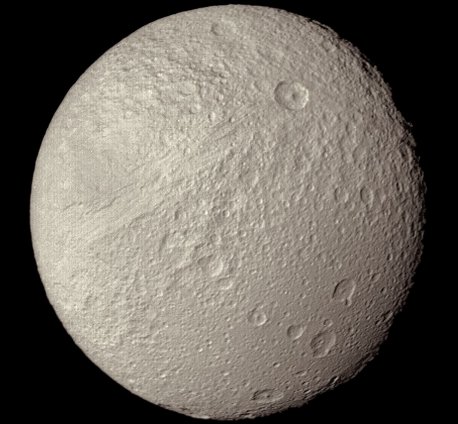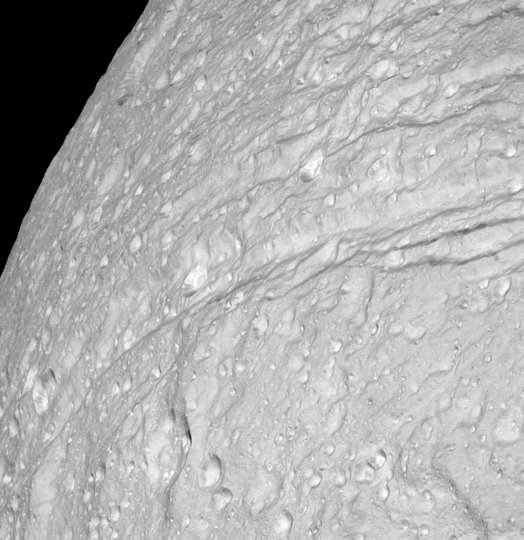Like Titan, Enceladus and Dione, the Saturnian moon Tethys is subjected to the warping and twisting effects of Saturn's tidal gravity. It show bright, relatively smooth and roughly circular surface patches where ponds of liquid water appear to have frozen across craters. These events likely happened relatively recently on geologic time scales.

|
Above: This view of Tethys was taken by Voyager 2 on August 26, 1981, from a range of 282,000 kilometers (175,000 miles).
The Cassini spacecraft was sent on its way to Saturn in 1997. Since then, it travelled nearly four billion kilometers, delivered a probe to Titan, discovered structures on Saturn's icy rings, detected organics on Titan and probable underground oceans on Titan, Enceladus, Dione and Thetys. From 2017 on, the probe will spiral down toward Saturn itself, streaming data to Earth before being torn apart.
Tethys is an icy moon of Saturn, about 294 km wide, similar in nature to Dione. Its density, equal to that of water, indicates that it is mainly composed of ice. The surface of Tethys is covered with craters and has many cracks caused by faults in the ice. There are two types of grounds on Tethys: one is composed of heavily cratered regions; the other consists of a dark, slightly cratered belt which crosses the moon through and through. The low number of craters on this area indicates that Tethys has certainly had internal activity previously, causing a partial upturn of the older terrain.
The exact reason for the dark color of the belt is unknown, but a possible interpretation comes from the recent images of the Galileo probe of the Jovian moons Ganymede and Callisto, both of which exhibit polar ice caps on the slopes of Craters facing the poles. At a distance, the polar ice caps seem brighter because of the thousands of pieces of ice in the small craters there. The surface of Tethys may have a similar origin, consisting of polar caps covered with indistinguishable pieces of ice, separated by a darker area.
The western hemisphere of Tethys is dominated by an enormous impact crater called Odyssey, whose 400 km diameter accounts for nearly two-fifths of Tethys. The crater has now flattened and follows the spherical form of Tethys, like the craters of Callisto, without the great chains of ring-shaped mountains and the central peak that can be seen on the moon and Mercury, the fragile layer of Tethys ice having leveled off over the ages.
The second most visible structure of Tethys is an enormous valley called Ithaca Chasma, 100 km wide and 3 to 5 km deep. 2,000 km long, it covers nearly 3/4 of the circumference of Tethys. It is believed that Ithaca Chasma was formed as the water inside Tethys solidified, causing an expansion of the moon and a cracking of the surface to allow for greater interior volume. The older craters that existed before the moon solidified were probably suppressed by the geological activity of the time. There is another theory about the formation of Ithaca Chasma: the impact at the origin of the great Odyssey crater was able to cause a shock wave that crossed Tethys, fracturing the fragile icy surface of the opposite face. The temperature at the surface of Tethys is -187 ° C.

|
Above: This view of the surface of Saturn's moon Tethys, taken during Cassini's close approach to the moon on Sept. 24, 2005, reveals an icy land of steep cliffs. The view is of the southernmost extent of Ithaca Chasma, in a region not seen by NASA's Voyager spacecraft.